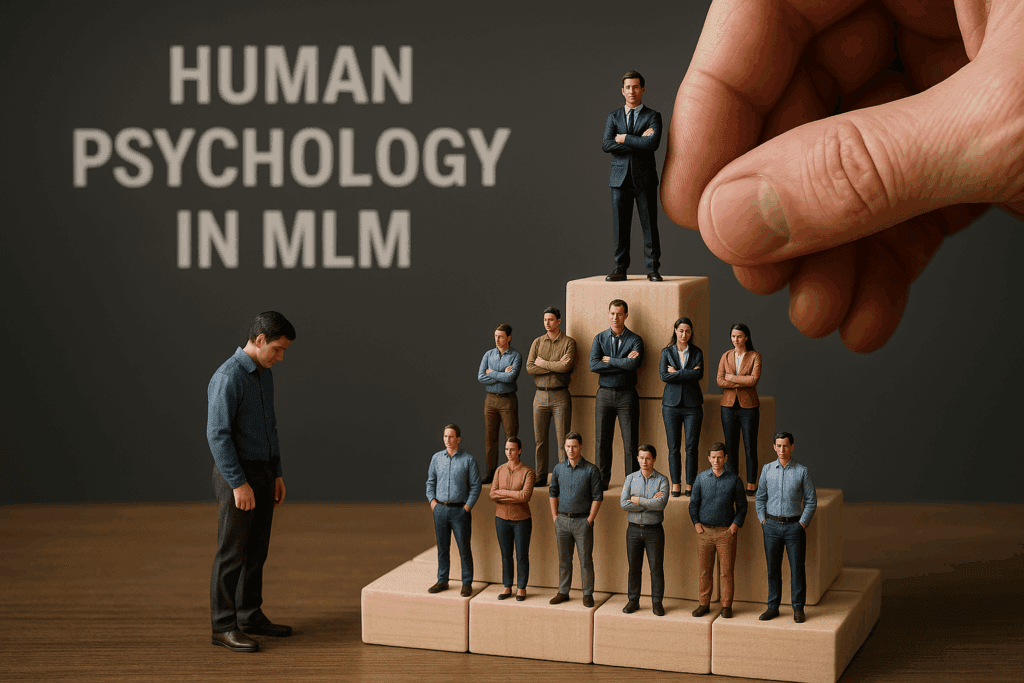Multi-level marketing companies know something most businesses don’t: the right software can turn ordinary people into motivated sellers by tapping into deep-seated psychological triggers. These systems don’t just track sales—they reshape how distributors think, feel, and act.
This guide is for MLM leaders, software developers, and business owners who want to understand how top-performing networks use technology to drive behavior and boost results.
We’ll break down the psychological foundations that make MLM systems work, revealing why some distributors stay motivated while others quit within months. You’ll discover how software features exploit natural human psychology, from gamification elements that trigger dopamine releases to social proof mechanisms that create unstoppable momentum.
Finally, we’ll examine behavioral design patterns in successful MLM platforms and explore how data-driven personalization maximizes influence by delivering exactly the right message at precisely the right moment.
Ready to see how psychology and technology team up to create unstoppable MLM machines? Let’s dive in.
Understanding the Psychological Foundations of MLM Success

How cognitive biases drive recruitment decisions
The human brain operates on mental shortcuts called cognitive biases, and successful MLM systems exploit these automatic thinking patterns to drive recruitment decisions. When someone considers joining an MLM network, they’re rarely making a purely rational calculation. Instead, their decision gets influenced by predictable psychological patterns that smart MLM platforms actively trigger.
The anchoring bias plays a huge role here. When MLM software presents potential earnings, it typically leads with impressive numbers – the top 1% of earners or theoretical maximum payouts. These figures become mental anchors that shape how prospects evaluate the opportunity. Even when realistic earnings data appears later, people’s brains remain tethered to those initial high numbers.
Confirmation bias works hand-in-hand with selective information presentation. MLM platforms carefully curate success stories, testimonials, and data points that support the narrative of easy wealth building. They create echo chambers where prospects primarily encounter positive reinforcement, making alternative viewpoints seem scarce or invalid.
The availability heuristic makes recent, vivid examples feel more probable than they actually are. MLM systems leverage this by prominently featuring fresh success stories, recent bonus announcements, and timely celebrations of achievements. When Jane from Ohio just earned her pink Cadillac, it feels like that outcome is much more likely for new recruits than statistical reality suggests.
Overconfidence bias convinces people they’ll perform better than average participants. MLM platforms feed this by emphasizing personal control over outcomes – “your success depends on your effort” – while downplaying market saturation, competition, and structural limitations that affect everyone regardless of individual dedication.
The power of social proof in network building
Social proof operates as one of the most powerful psychological drivers in MLM success, and modern software systems have perfected ways to manufacture and amplify it. People naturally look to others’ behavior to guide their own decisions, especially in uncertain situations. MLM platforms exploit this tendency through sophisticated social proof mechanisms.
Real-time activity feeds create artificial urgency and momentum. When prospects see notifications like “Sarah just joined!” or “Mike earned his first commission!” every few minutes, it creates the impression of widespread participation and success. These systems often aggregate activity across multiple time zones and regions to maintain constant social validation streams.
Ranking systems and leaderboards tap into competitive social dynamics while providing continuous proof of others’ engagement. Members see their position relative to peers, creating both motivation to climb higher and evidence that others are actively participating and succeeding. The psychological impact doubles when these rankings tie to visible rewards or recognition.
MLM software creates artificial scarcity through social proof by displaying how many people are “viewing this opportunity” or how spots in certain programs are “filling up fast.” These notifications trigger fear of missing out while suggesting high demand through others’ behavior.
Community features within MLM platforms amplify social proof through user-generated content. Success photos, testimonial videos, and celebration posts create authentic-seeming evidence that the system works. The software often promotes this content strategically, ensuring new prospects encounter social proof at critical decision points.
Geographic and demographic targeting makes social proof more relevant and persuasive. When prospects see people from their own area, background, or life circumstances succeeding, the social proof feels more applicable to their own situation.
Leveraging loss aversion to increase retention rates
Loss aversion – the psychological principle that people feel losses more intensely than equivalent gains – becomes a powerful retention tool in MLM systems. People will work harder to avoid losing something they have than to gain something new of equal value. Smart MLM software exploits this bias through carefully designed features that make leaving feel costly.
Status preservation mechanisms create artificial losses when members consider quitting. MLM platforms assign titles, ranks, and recognition levels that become part of members’ identity. Leaving means losing not just potential income, but social status, community position, and personal achievement markers. The software often displays how close someone is to losing their current rank, making inaction feel like active loss.
Sunk cost emphasis reminds members of their accumulated investments – time, money, relationships, and effort already committed. MLM systems track and display these investments prominently, making departure feel like waste rather than rational decision-making. Progress tracking shows how much work would be “thrown away” by leaving.
Investment protection framing positions continued participation as protecting existing assets rather than pursuing new opportunities. MLM software presents ongoing fees, purchases, and activities as maintaining current position rather than additional costs. This reframing makes continued spending feel defensive rather than speculative.
Relationship hostage situations create social losses around departure. MLM systems encourage deep integration with other members’ success – when your downline depends on your continued participation, leaving means harming people you care about. The software facilitates these interdependent relationships strategically.
Time-sensitive bonus structures and qualification periods create rolling loss windows. Members face losing monthly bonuses, quarterly achievements, or annual recognition if they don’t maintain activity levels. These systems ensure that there’s always something immediate at risk, making any given month feel like the wrong time to quit.
Community integration makes leaving feel like social exile. MLM platforms create exclusive groups, private communication channels, and special events that become significant parts of members’ social lives. Departure means losing access to communities that may have become primary social connections.
Software Features That Exploit Human Psychology

Gamification Elements That Trigger Dopamine Responses
Modern MLM software taps into the brain’s reward system through carefully crafted gamification features. Progress bars fill up as users complete tasks, creating that satisfying visual confirmation that something is being accomplished. Point systems award immediate feedback for every action – recruiting a new member, making a sale, or attending a training session. These micro-rewards trigger small dopamine hits that keep users engaged and coming back for more.
Achievement badges work particularly well because they create clear milestones. “Bronze Recruiter,” “Silver Seller,” or “Diamond Leader” aren’t just titles – they’re digital trophies that users can display and share. The software often includes notification sounds and visual celebrations when these milestones are reached, amplifying the psychological impact.
Leaderboards add another layer by displaying real-time rankings. Seeing your name climb up the list creates excitement, while dropping down creates urgency to take action. Daily challenges and streak counters capitalize on loss aversion – once someone has built a 30-day streak of activity, they’ll work hard not to break it.
Social Comparison Tools That Fuel Competitive Behavior
MLM platforms excel at creating environments where constant comparison becomes inevitable. Team dashboards display everyone’s performance metrics side-by-side, making it impossible to ignore how you stack up against your peers. These comparison tools don’t just show raw numbers – they often highlight percentage improvements, making smaller players feel they can compete with top performers.
Social proof features amplify this effect by showcasing success stories prominently. When the software automatically posts achievements to team feeds or creates “spotlight” sections for high performers, it creates both inspiration and envy. This drives others to increase their efforts to gain similar recognition.
Geographic competition features add another dimension by comparing performance across regions or teams. Someone might be average in their immediate group but top performer in their city, giving them multiple ways to feel competitive and successful.
Progress Tracking Systems That Create Commitment Loops
Visual progress tracking transforms abstract goals into concrete, measurable journeys. MLM software typically breaks down large objectives into smaller, achievable steps displayed through progress wheels, completion percentages, and milestone markers. This makes overwhelming targets feel manageable while creating psychological investment in the outcome.
The commitment loop strengthens when users input their own goals into the system. Once someone has told the software they want to recruit 10 people this month, the platform can send daily reminders, show daily progress, and create urgency as deadlines approach. Personal investment in goal-setting makes abandonment feel like personal failure.
Streak tracking and consistency metrics add behavioral stickiness. When the software shows someone has been active for 45 consecutive days, breaking that streak requires overcoming significant psychological resistance. Combined with progress toward larger goals, these systems create multiple reasons to stay engaged.
Automated Recognition Features That Satisfy Ego Needs
Smart MLM software doesn’t wait for managers to recognize achievements – it automatically celebrates successes the moment they happen. Instant notifications, congratulatory messages, and automated social media posts ensure no accomplishment goes unnoticed. This immediate recognition satisfies the human need for acknowledgment without relying on busy uplines to provide it.
Personalized recognition goes beyond generic congratulations. The software tracks individual preferences and achievements to create customized celebration messages. Someone who values family time might receive recognition that emphasizes how their success helps their children, while someone focused on financial freedom gets messages about income milestones.
Public recognition features amplify the ego satisfaction by broadcasting achievements to the entire network. Automated posts to team walls, email newsletters featuring top performers, and special recognition sections make individual success visible to hundreds or thousands of people. This public validation creates powerful motivation to continue performing and reaching higher levels.
Behavioral Design Patterns in Top-Performing MLM Platforms

Onboarding sequences that build immediate momentum
Smart MLM platforms recognize that the first 48 hours determine whether a new recruit stays or walks away. The most effective onboarding sequences tap into what psychologists call the “fresh start effect” – that burst of motivation people feel when beginning something new.
Top-performing platforms break down the initial experience into bite-sized wins. Rather than overwhelming newcomers with complex training modules, they start with simple actions that deliver instant gratification. New members might complete their profile, watch a short welcome video, and connect with their sponsor – each step triggering a small dopamine hit through progress indicators and congratulatory messages.
The psychology here is brilliant. These platforms create what behavioral scientists call “implementation intentions” – specific if-then plans that make success more likely. For example: “If you complete your profile today, then you’ll unlock access to your personalized dashboard.” This approach reduces decision fatigue while building confidence through early victories.
Many successful MLM systems also leverage social proof during onboarding. New members see testimonials, success stories, and real-time notifications of others joining or achieving milestones. This creates a sense of belonging to something bigger and reinforces the decision to participate.
The smartest platforms time their onboarding communications perfectly. They send encouragement messages right when motivation typically dips, usually around day 3-5, keeping momentum alive during that critical early period.
Goal-setting frameworks that maximize achievement drive
Effective MLM software transforms vague dreams into concrete, achievable targets through sophisticated goal architecture. These systems understand that humans are wired to pursue specific, time-bound objectives rather than abstract aspirations like “financial freedom.”
The best platforms use what researchers call “hierarchical goal structures.” Members set big-picture objectives (like earning $5,000 monthly) which the software automatically breaks down into smaller milestones (recruit 3 people this month, generate $500 in sales this week). This approach prevents overwhelm while maintaining focus on the ultimate prize.
Visual progress tracking plays a huge role in sustaining motivation. Members see thermometer-style progress bars, completion percentages, and countdown timers that create urgency. The software celebrates micro-achievements – hitting 25% of a sales goal triggers confetti animations or badge unlocks, keeping dopamine levels elevated throughout the journey.
Smart MLM platforms also implement “stretch goals” strategically. Once someone consistently hits their targets, the system suggests slightly more ambitious objectives. This taps into the psychological principle of “goal gradient effect” – people work harder as they get closer to completing something.
Competition elements amplify the achievement drive even further. Leaderboards, team challenges, and peer comparisons activate our innate desire to outperform others. Members can see how they rank against teammates or company-wide performers, adding social pressure that motivates action.
Communication tools that strengthen emotional bonds
The most successful MLM platforms recognize that people don’t just buy products or opportunities – they buy relationships and belonging. Their communication features are designed to foster genuine connections between team members at every level.
Integrated messaging systems go beyond basic chat functionality. They include features like voice messages, photo sharing, and celebration tools that help team members share victories together. When someone hits a milestone, the software makes it easy for others to send congratulations, creating positive feedback loops that strengthen group cohesion.
Mentorship matching algorithms pair new recruits with experienced members based on personality assessments, goals, and communication styles. This isn’t random – the software analyzes successful pairings to improve future matches. Strong mentor relationships dramatically increase retention rates because people feel supported and guided rather than abandoned.
Group communication features tap into pack mentality psychology. Team chat rooms, announcement broadcasts, and group video calls create shared experiences that build loyalty. Members develop inside jokes, celebrate together, and support each other through challenges – exactly what happens in tight-knit communities.
The smartest platforms also facilitate upward communication. Team members can easily reach their uplines for advice, creating accessibility that builds trust. Automated check-in prompts remind leaders to connect with their teams regularly, ensuring no one feels forgotten or neglected in the network structure.
Data-Driven Personalization for Maximum Influence

Personality Profiling Algorithms That Customize Experiences
Modern MLM platforms collect thousands of data points about each member’s digital behavior, from click patterns to response times on messages. This information feeds sophisticated algorithms that build detailed psychological profiles, identifying whether someone is driven by competition, recognition, financial security, or social connection.
These systems analyze communication styles, preferred content types, and interaction patterns to determine personality traits. A member who frequently shares success stories might be classified as recognition-seeking, while someone who consistently asks detailed questions about compensation plans shows profit-focused motivation. The software then tailors every aspect of the user experience accordingly.
The personalization extends beyond simple categorization. Advanced platforms create dynamic user journeys that adapt in real-time. Someone identified as analytically-minded receives detailed performance metrics and growth projections, while relationship-oriented users see more team-building content and social features.
Behavioral Analytics That Predict Member Actions
Predictive modeling has revolutionized how MLM systems identify at-risk members before they disengage. By tracking engagement patterns, login frequency, and participation in training sessions, these systems can predict with remarkable accuracy who’s likely to quit within the next 30 days.
The analytics go deeper than surface-level activity. They examine micro-behaviors: how long someone spends reading compensation materials, whether they scroll through team rankings, or if they immediately close promotional emails. These behavioral fingerprints reveal true interest levels versus polite engagement.
Machine learning algorithms continuously refine their predictions by analyzing successful retention interventions. They learn which combinations of outreach timing, message content, and incentive offers work best for different personality types and engagement levels.
Targeted Messaging Systems That Increase Engagement Rates
Smart MLM platforms deploy messaging systems that feel personal while operating at scale. These systems analyze individual communication preferences, optimal contact times, and response triggers to craft messages that resonate with each recipient’s psychological profile.
The messaging adapts to communication style preferences. Some members respond better to urgent, action-oriented language, while others prefer collaborative, supportive tones. The system automatically adjusts vocabulary, sentence structure, and emotional appeals based on past response patterns.
Timing optimization plays a crucial role in message effectiveness. The software learns when each member is most likely to engage, whether that’s Monday mornings or Sunday evenings, and schedules communications accordingly. This personalized timing can increase open rates by up to 40% compared to standard broadcast messaging.
Adaptive Reward Structures Based on Individual Motivations
The most sophisticated MLM systems move beyond one-size-fits-all reward programs to create personalized incentive structures. By analyzing what truly motivates each member, these platforms can adjust rewards to maximize psychological impact while minimizing costs.
For status-driven individuals, the system might emphasize public recognition, leaderboard positions, and exclusive titles. Money-motivated members receive clearer focus on commission structures and bonus opportunities. Those seeking personal development get access to training programs and mentorship opportunities as primary rewards.
The adaptability extends to reward timing and presentation. Some members respond better to frequent small wins, while others prefer building toward larger milestones. The system adjusts achievement thresholds, celebration frequency, and reward visibility based on individual psychological profiles, creating a customized motivation engine for each participant.
Creating Sustainable Psychological Engagement

Long-term motivation strategies beyond initial excitement
The honeymoon phase in MLM participation typically lasts 30-90 days before reality sets in. Smart MLM software combats this predictable decline through graduated achievement systems that mirror video game progression mechanics. Instead of front-loading rewards, successful platforms create milestone ladders with increasingly valuable incentives spaced at strategic intervals.
Progressive skill unlock systems work particularly well here. New distributors start with basic features, gradually gaining access to advanced tools, exclusive content, and premium support channels as they demonstrate consistent activity. This approach transforms the software itself into a reward, making users feel they’re earning privileges rather than simply accessing features.
Seasonal challenges and rotating focus areas prevent stagnation. Rather than maintaining static goals year-round, dynamic systems introduce quarterly themes like “recruitment mastery” or “customer retention excellence.” Each theme brings fresh training materials, specialized contests, and targeted recognition programs that re-energize participants who might otherwise lose interest.
Smart platforms also implement “comeback campaigns” triggered by declining activity patterns. When the system detects reduced engagement, it automatically enrolls inactive members in re-engagement sequences featuring success stories from similar demographics, simplified action plans, and limited-time incentives designed to restart momentum without overwhelming the participant.
Community building features that foster belonging
Humans are hardwired for tribal belonging, and successful MLM software exploits this need through carefully designed social architecture. The most effective platforms create multiple layers of community membership, from broad company-wide groups down to intimate mentorship circles of 8-12 members.
Status-based community tiers work exceptionally well because they satisfy both inclusion and exclusivity needs simultaneously. Bronze, Silver, and Gold member communities each offer unique benefits, private discussion areas, and exclusive access to leadership. Members can see what they’re working toward while feeling special about their current level.
Geographic proximity features tap into natural human preferences for local connections. Smart systems automatically suggest nearby team members for coffee meetings, create regional leaderboards, and organize local success celebrations. These face-to-face touchpoints strengthen digital relationships and create accountability networks that extend beyond the platform.
Peer mentorship matching algorithms pair experienced distributors with newcomers based on personality assessments, goals, and communication preferences. Rather than random assignments, data-driven compatibility matching increases the likelihood of meaningful relationships forming, which directly correlates with retention rates.
Recognition walls and achievement galleries serve dual purposes: they celebrate individual success while creating social proof that motivates others. Smart platforms personalize these displays, showing achievements from people in similar situations or demographics to make success feel more attainable.
Skill development pathways that enhance self-efficacy
Self-efficacy—the belief in one’s ability to succeed—is perhaps the strongest predictor of MLM longevity. Advanced platforms build this confidence through microlearning sequences that break complex skills into digestible chunks, ensuring users experience frequent wins rather than overwhelming challenges.
Adaptive learning paths adjust content difficulty based on user performance and engagement patterns. If someone struggles with prospecting calls, the system automatically provides additional practice scenarios, confidence-building exercises, and success story examples before moving to advanced techniques. This personalized pacing prevents the frustration that drives people away.
Skill certification programs create tangible proof of competency that participants can showcase to prospects and team members. Digital badges for achievements like “Customer Service Excellence” or “Presentation Mastery” satisfy the human need for credentialing while providing conversation starters for networking situations.
Real-time coaching features use AI to analyze call recordings, email communications, and presentation deliveries, providing immediate feedback on areas for improvement. Rather than waiting for weekly team calls or monthly training events, participants receive continuous skill refinement that accelerates their development curve.
Progress visualization tools show skill development over time through charts, graphs, and competency radar diagrams. Seeing measurable improvement in communication skills, product knowledge, or leadership capabilities reinforces the value of continued effort and time investment.
Crisis management tools that maintain loyalty during setbacks
Every MLM participant faces discouraging periods—failed presentations, rejected prospects, team member departures, or personal challenges that disrupt focus. Sophisticated platforms anticipate these inevitable setbacks and deploy psychological first aid through automated intervention systems.
Mood tracking integrations monitor user sentiment through communication patterns, activity levels, and explicit mood check-ins. When the system detects declining emotional states, it triggers supportive interventions like inspirational content delivery, connection with upline mentors, or access to peer support groups facing similar challenges.
Perspective reframing tools help users interpret setbacks as learning opportunities rather than failures. Interactive modules guide participants through cognitive restructuring exercises, helping them identify limiting beliefs and replace them with growth-oriented mindsets. These tools draw from cognitive behavioral therapy techniques adapted for business contexts.
Emergency support networks activate when users report serious consideration of quitting. Instead of generic retention emails, crisis management protocols connect struggling members with success coaches who share similar backgrounds and have overcome comparable obstacles. This human touch often prevents departures that automated responses cannot address.
Comeback planning features help users develop specific action plans for returning to productive activity after discouraging periods. Rather than expecting immediate return to peak performance, these tools create gentle re-entry strategies that rebuild confidence gradually while maintaining momentum toward larger goals.

MLM platforms have cracked the code on what makes people tick. They use smart software to tap into our deepest psychological needs – the desire to belong, achieve, and earn recognition. These systems don’t just track sales numbers; they create personalized experiences that keep distributors motivated through gamification, social proof, and carefully timed rewards. The most successful platforms understand that people make decisions based on emotions first, then justify them with logic later.
Smart MLM software designers know exactly which buttons to push. They’ve figured out how to use data to predict when someone might quit and intervene with just the right incentive or recognition. If you’re building or choosing an MLM platform, look for systems that balance psychological engagement with genuine value creation. The most sustainable networks are those that channel human psychology toward building real relationships and delivering actual products people want, not just feeding into endless recruitment cycles.



